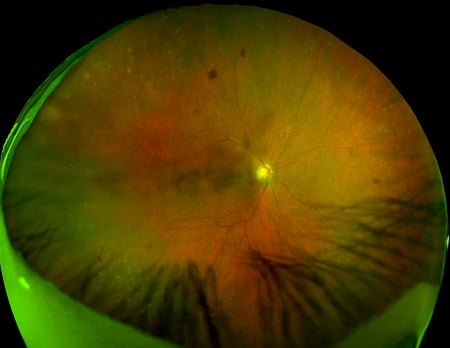Q&A: How optomap® has Impacted Vista Eye Care's Practice
Vista Eye Care recently provided us with a Q&A session with Dr. Christine Bartoletti to discuss how optomap has changed their practice. We wanted to share some salient points from this interview, so you could see how Optos technology can work for your practice and patients.

optomap images showing diabetic retinopathy hemorrhages and drusen in the periphery.
Please read this brief highlight of the interview to learn about some of the benefits Vista Eye Care has experienced with our ever advancing technology.
How does optomap work and why should it be used?
To determine the health of the retina, optomap enables us to take an ultra-widefield image, which images 200 degrees or 82% of the retina. We recommend that it be used as part of a regular comprehensive annual eye exam because the year-over-year images can be compared at each assessment to plan any necessary treatments.
Why did you want this technology to be a part of your practice?
With optomap, I’m able to achieve a wider view of the retina without having to dilate my patients’ eyes. Additionally, I can compare images from one year to the next to detect changes easier and make earlier diagnoses.
Is the experience frightening or difficult for your patients?
Thanks to Optos, patients simply sit and look at a target through the eye piece. The process only requires adjusting the patient’s head so you have an optimal view and either touching a button on a tablet or having the device “auto-capture” the digital, retinal image. The whole exam takes roughly two to three minutes, with the image capture taking less than a second, as opposed to the 30 or so minutes for dilation exams. The patients’ vision is not affected at all.
Have you personally diagnosed conditions you may not have been able to with previous technologies?
I was able to detect glaucoma early because of optomap. Compared to previous images, I noticed that there were changes in the optic nerve. I have also found early, mild diabetic retinopathy and was able to begin treatment earlier than I would have in the past.
Optos likes to partner with their customers in order to help eye care professionals detect and treat patients earlier, using optomap ultra-widefield retinal imaging. Our technology can help your practice increase its bottom line. Contact us today to learn how to bring optomap to your practice.